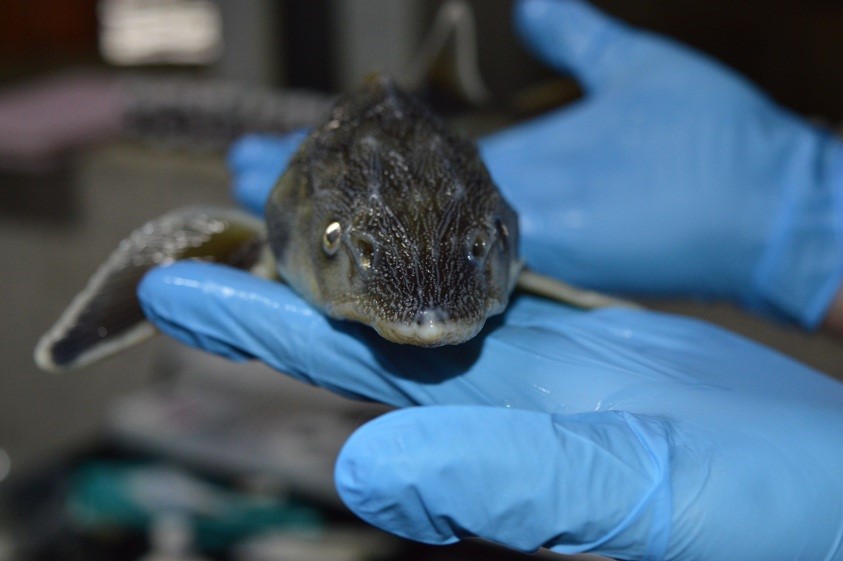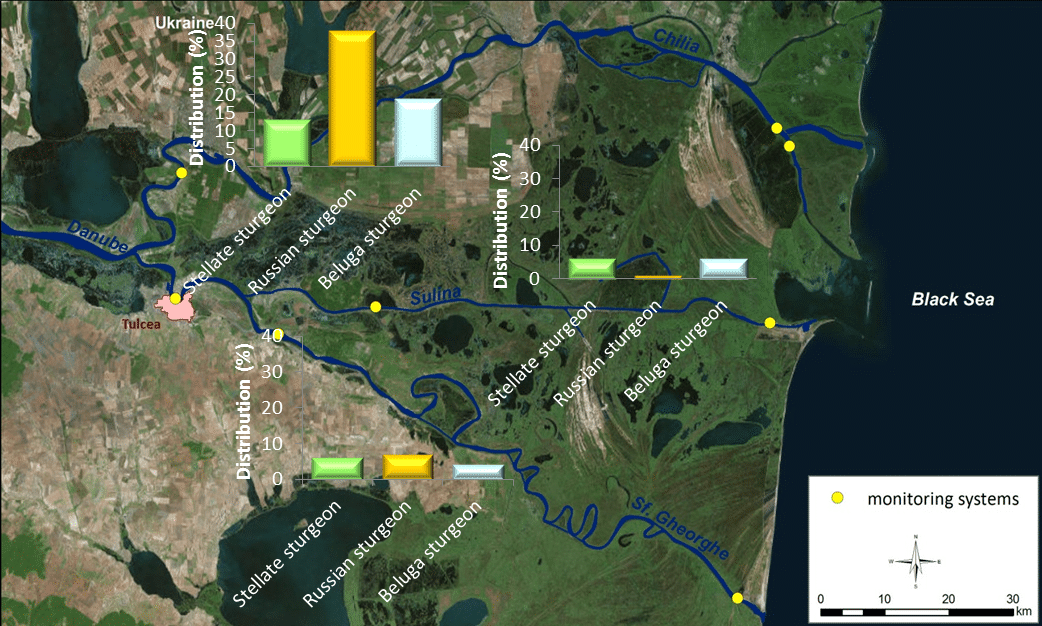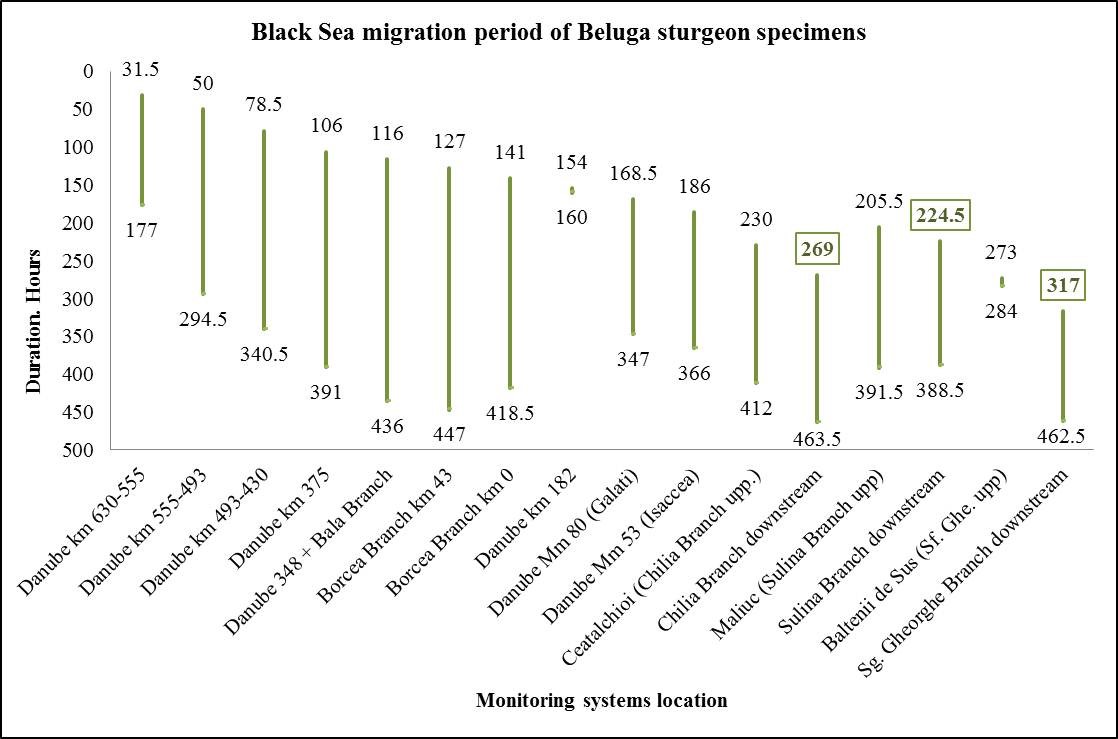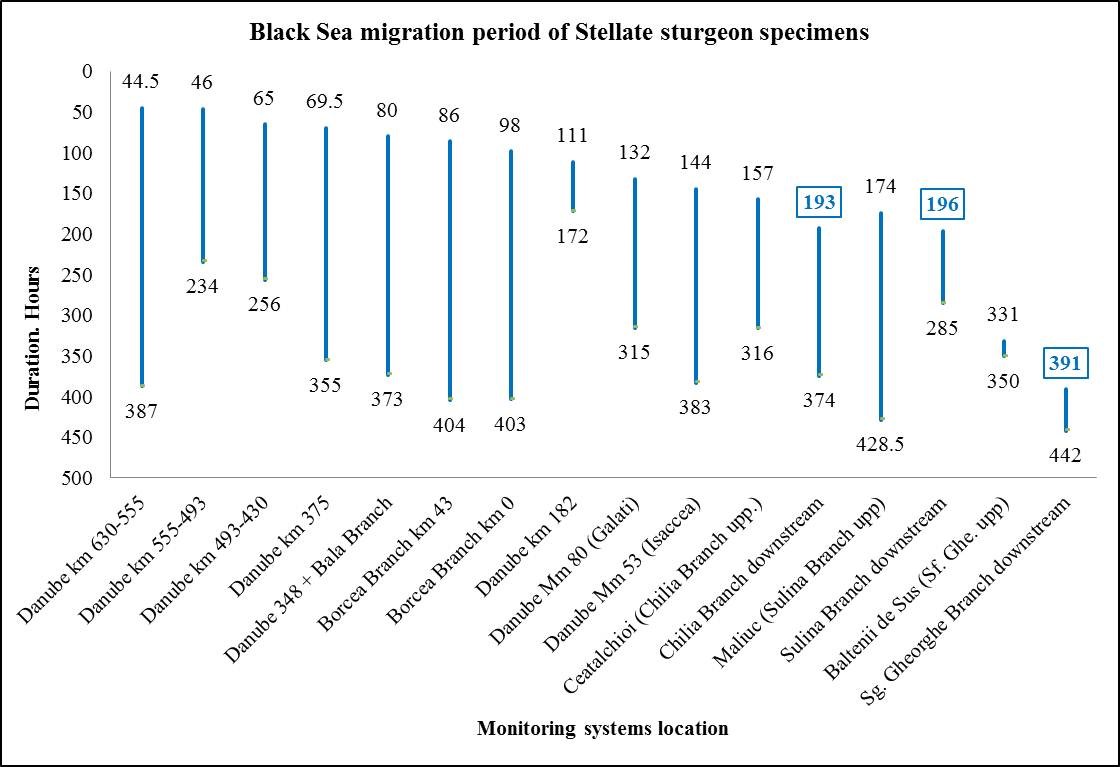- Home
- About Us
- Scientific Departments
- Laboratories Department
- Environmental Quality Assessment
- Waste Management
- Natural and Technological Hazards
- Numerical Modeling And Geographic Information Systems
- Impact of Built Environment and Nanomaterials
- Engineering For Environmental Protection And Impact Assessment
- Climate Change And Sustainable Development
- Biodiversity And Ecosystem Dynamics Department
- Management Of Natural Resources And Green Energy
- Research activity
- Projects
- Reports
- News
- Contact
Evaluarea supraviețuirii și răspândirii în Marea Neagră a puilor de sturion din speciile amenințate critic lansați în Dunărea Inferioară – Proiect Pilot

Activitatea desfășurată de către institut în acest parteneriat a constat în monitorizarea traseului parcurs de puii de sturioni produși în acvacultură și eliberați în Dunăre în vederea repopulării de susținere a populațiilor de sturioni sălbatici, utilizând metoda telemetriei ultrasonice. Experții INCDPM pe lângă experiența acumulată în peste 5 ani de monitorizare a migrație sturionilor adulți având la baza telemetria ultrasonică, au consultat și bibliografia de specialitate în vederea găsirii celei mai bune metode de marcare și monitorizare a puilor de sturioni care să nu afecteze sau să influențeze viața acestora. În acest sens mărcile utilizate pentru marcarea puilor au fost de mici dimensiuni, iar după inserarea abdominală a acestora s-a utilizat un adeziv tisular care să protejeze zona inciziei de eventuale infecții. Astfel în vederea îndeplinirii acestei activități, experții INCDPM au marcat, în fermele de creștere a sturionilor, cu mărci ultrasonice peste 100 de exemplare de pui de sturion din cele 3 specii migrator anadrome (Acipenser stellatus – păstrugă, Acipenser gueldenstaedtii – nisetru și Huso huso – morun) și au montat stații de monitorizare dotate cu receptoare capabile să primească semnalul transmis de mărcile implantate în cavitatea abdominală a puilor de sturioni pe tronsonul Dunării cuprins între Porțile de Fier și Marea Neagră. După marcare exemplarele au fost supravegheate în ferme timp de o săptămână pentru a observa comportamentul acestora în raport cu tehnica de marcare utilizată, rezultatul fiind unul mai mult decât satisfăcător, deoarece peștii nu au manifestat schimbări de comportament și nu s-au înregistrat mortalități. Pe lângă monitorizarea cu stațiile fixe, s-a realizat și o monitorizare mobilă cu ajutorul unui receptor mobil amplasat pe o ambarcațiune, unde o echipă de experți a parcurs tronsonul cuprins între eliberarea puieților marcați și până la vărsarea în Marea Neagră, urmărind în timp real migrația acestora. Rezultatele obținute sunt unice și reprezintă o premieră la nivelul bazinului hidrografic al Dunării.
- Parteneri
Dunărea de Jos” University from Galați - Responsabili de Proiect
Responsabil: Dr. ecol. Holban Elena, Cercetător Științific III
Responsabil adjunct: Ecol. Dănălache Tiberius, Cercetător Științific;
Zooteh. eng. Cristea Alexandru, Cercetător Științific III;
Dr. zooteh. eng. Badilita Alin, Cercetător Științific III;
Eng. Zamfir Stefan, Cercetător Științific;
Geogr. Cornateanu Gabriel, Cercetător Științific;
Ec. Gheorghe Ionuț, Asistent de cercetare științifică
- Perioada de desfășurare
04.2013 – 04.2015 - Finanțat prin
Fondul european pentru pescuit și afaceri maritime (FEPAM)
Obiective
General
Marcarea și monitorizarea comportamentului prin utilizarea telemetriei ultrasonice, a puilor de sturioni produși în sistem de acvacultură și eliberați pentru repopulare pe cursul Dunării în vederea susținerii populațiilor sălbatice.
Specifice:
- Identificarea comportamentului puilor de sturion în raport cu tehnica de marcare utilizată în vederea monitorizării.
- Determinarea traseelor de migrației a puilor de sturion și distribuția acestora pe cele trei brațe principale ale Deltei Dunării (Chilia, Sulina și Sfântul Gheorghe).
- Evaluarea ratei de succes definită prin numărul de exemplare ce a ajuns în Marea Neagră din numărul total de pui de sturion marcați ultrasonic.
Rezultate
Monitorizarea puilor de sturioni s-a realizat prin utilizarea telemetriei acustice pe sectorul cuprins între localitatea Corabia, km 633 al Dunării și până la vărsarea în Marea Neagră pe cele 3 brațe: Chilia, Sulina și Sf. Gheorghe.
Montarea stațiilor de recepție s-a făcut cu ajutorul unor sisteme de monitorizare elaborate de experții INCDPM și prezentate în multiple lucrări științifice (Bâdiliță A.M., et.al., 2013; Deák Gy., et.al., 2013, 2014; Raschi M.C., et.al., 2016) care încorporează aceste echipamente și care au fost montate în așa fel încât să poată capta cât mai bine semnalul acustic transmis de mărci prin apă. Cele două sisteme de monitorizare sunt de două tipuri plutitor (DKMR-01T) și fix (DKTB), ambele propuse pentru brevetare la Oficiul pentru Invenții și Mărci (OSIM).
Prin urmărirea comportamentului puilor de sturioni marcați ultrasonic s-a putut obține o bază de date unică la nivelul bazinului hidrografic al Dunării, iar prin prelucrarea acesteia obținându-se rezultate precum:
- Stabilirea traseelor principale de migrare a puilor de sturioni cu accent pe rutele preferate de aceștia în drumul lor spre habitatele prielnice din Marea Neagră;
- Distribuția puilor de sturioni marcați ultrasonic la nivelul Deltei Dunării, observându-se preferința acestora pentru un anumit braț;
- Timpul scurs de la eliberarea exemplarelor de puiet de sturion marcate și până la ajungerea acestora la Marea Neagră;
- Distribuția diurnă/nocturnă a detecțiilor puilor de sturioni marcați ultrasonic, pentru observarea intensității migrației acestora în funcție de perioada zilei;
- Stabilirea debitelor în zonele de interes și evidențierea influenței acestora asupra migrației puilor de sturioni;
- Realizarea de hărți cu traseele de migrare ale puilor de sturioni.

The activity carried out by the institute in this partnership consisted of the monitoring sturgeon juveniles routes produced in aquaculture and released into the Danube to restocking the populations of wild sturgeons using the ultrasonic telemetry method. INCDPM experts, in addition to the experience gained in over 5 years of monitoring the migration of adult sturgeon based on ultrasonic telemetry, have also consulted the specialized bibliography in order to find the best method of tagging and monitoring sturgeon juveniles which do not affect or influence their life. In this respect, the tags used for the juveniles tagging were of small size and after their abdominal insertion a tissue adhesive was used to protect the incision area from possible infections.
Thus, in order to accomplish this activity, INCDPM experts tagged, in the sturgeon farms, with ultrasonic tags, over 100 specimens of sturgeon juveniles of the three anadromous migratory species (Acipenser stellatus – stellate sturgeon, Acipenser gueldenstaedtii – russian sturgeon și Huso huso – beluga) and have installed monitoring stations equipped with receivers capable of receiving the signal transmitted by the tags implanted into the abdominal cavity of the sturgeon juveniles on the Danube section between the Iron Gates and the Black Sea.
After tagging, the specimens were observed on the farms for one week to monitor their behavior in relation to the tagging technique used, the result being more than satisfactory because the fishes did not show any behavioral changes and no mortality was recorded. The results are unique and represent a premiere at the level of Danube river basin.
In addition to monitoring with the fixed stations, mobile monitoring was carried out using a mobile receiver located on a boat, where an expert team has crossed the section between the release of the tagged juveniles and the spilling into the Black Sea, tracking in real time their migration.
Thus, in order to accomplish this activity, INCDPM experts tagged, in the sturgeon farms, with ultrasonic tags, over 100 specimens of sturgeon juveniles of the three anadromous migratory species (Acipenser stellatus – stellate sturgeon, Acipenser gueldenstaedtii – russian sturgeon și Huso huso – beluga) and have installed monitoring stations equipped with receivers capable of receiving the signal transmitted by the tags implanted into the abdominal cavity of the sturgeon juveniles on the Danube section between the Iron Gates and the Black Sea.
After tagging, the specimens were observed on the farms for one week to monitor their behavior in relation to the tagging technique used, the result being more than satisfactory because the fishes did not show any behavioral changes and no mortality was recorded. The results are unique and represent a premiere at the level of Danube river basin.
In addition to monitoring with the fixed stations, mobile monitoring was carried out using a mobile receiver located on a boat, where an expert team has crossed the section between the release of the tagged juveniles and the spilling into the Black Sea, tracking in real time their migration.
- Partners
Dunărea de Jos” University from Galați - Project Coordinators
Dr. ecol. Holban Elena, Scientific Researcher III
Ecol. Dănălache Tiberius, Scientific Researcher
Zooteh. eng. Cristea Alexandru, Scientific Researcher III
Dr. zooteh. eng. Badilita Alin, Scientific Researcher III
Eng. Zamfir Stefan, Scientific Researcher
Geogr. Cornateanu Gabriel, Scientific Research Assistent
Ec. Gheorghe Ionuț, Scientific Research Assistent
- Period
04.2013 – 04.2015 - Financed via
European Fisheries Fund through the Managing Authority of the Operational Program for Fisheries
Obiectives
General
Tagging and monitoring through ultrasonic telemetry of sturgeon juveniles behavior produced in aquaculture and released for restocking along the Danube to support wild populations..
Specific objectives:
1. Identification of the sturgeon juveniles behavior in relation to the tagging technique used for monitoring.
2. Determination of sturgeon juveniles migration routes and their distribution on the three main branches of the Danube Delta (Chilia, Sulina and Sf. Gheorghe).
3. Evaluation of the success rate defined by the number of specimens arriving in the Black Sea from the total number of ultrasonically tagged sturgeon juveniles.
Results
Monitoring of the sturgeon juveniles was realized through acoustic telemetry on the sector between Corabia, km 633 of the Danube and up to the spilling into the Black Sea on the three branches: Chilia, Sulina and Sf. Gheorghe. The installation of the receiver stations was done using monitoring systems developed by experts INCDPM and presented in several scientific papers (Bâdiliță A.M., et.al., 2013; Deák Gy., et.al., 2013, 2014; Raschi M.C., et.al., 2016) which incorporates these equipments and which have been mounted in such a way as to be able to capture as best as possible the sound signal transmitted by the tags through the water. The two monitoring systems are of two types: floating (DKMR-01T) and fixed (DKTB) types, both proposed for patent at the Office for Inventions and Trademarks (OSIM).
By monitoring the behavior of ultrasonically tagged sturgeon juveniles, a unique database was obtained at the level of the Danube river basin, and by processing it obtained results such as:
By monitoring the behavior of ultrasonically tagged sturgeon juveniles, a unique database was obtained at the level of the Danube river basin, and by processing it obtained results such as:
- Establish the main sturgeon juveniles migration routes with an emphasis on their favorite routes on their way to the favorable habitats from the Black Sea;
- Distribution of ultrasonically tagged sturgeon juveniles at the Danube Delta level, observing their preference for a particular branch;
- The time elapsed since the release of the tagged sturgeon specimens until their arrival at the Black Sea;
- Daily/nocturnal distribution of ultrasonically tagged sturgeon for observation of their migration intensity according to daytime;
- Establishing the debits in the areas of interest and highlighting their influence on the sturgeon juveniles migration;
- Maps with of sturgeon juveniles migratory routes.




